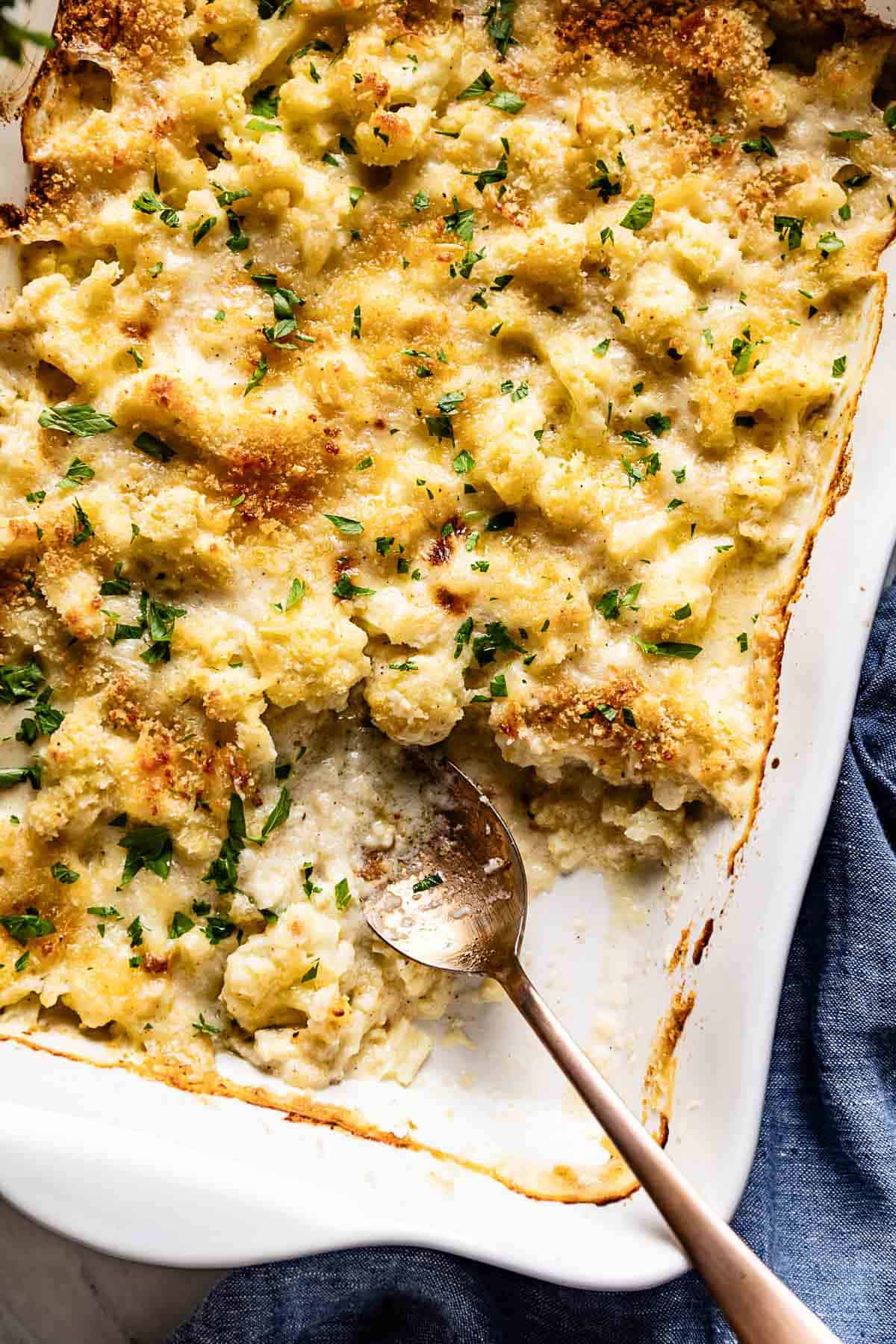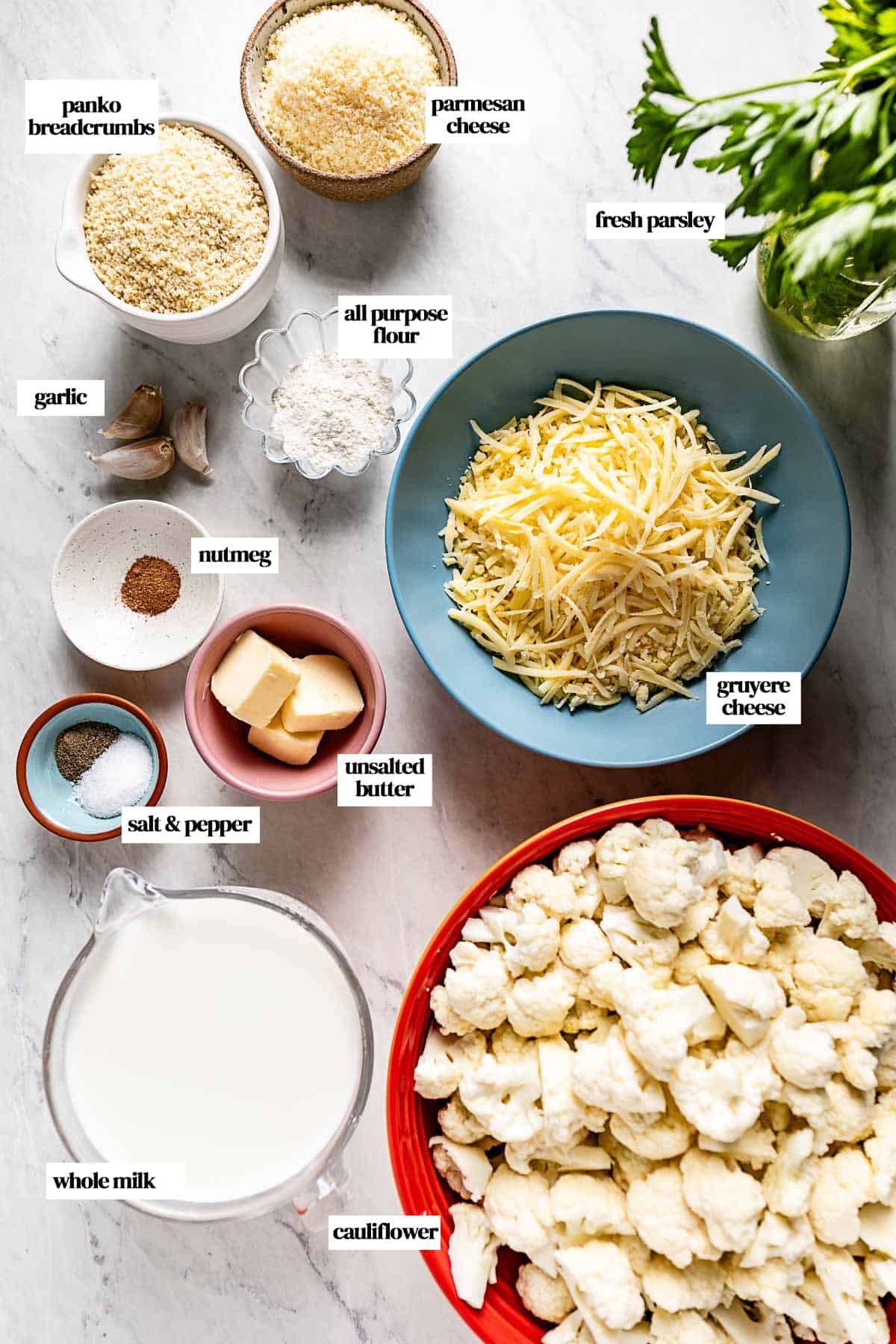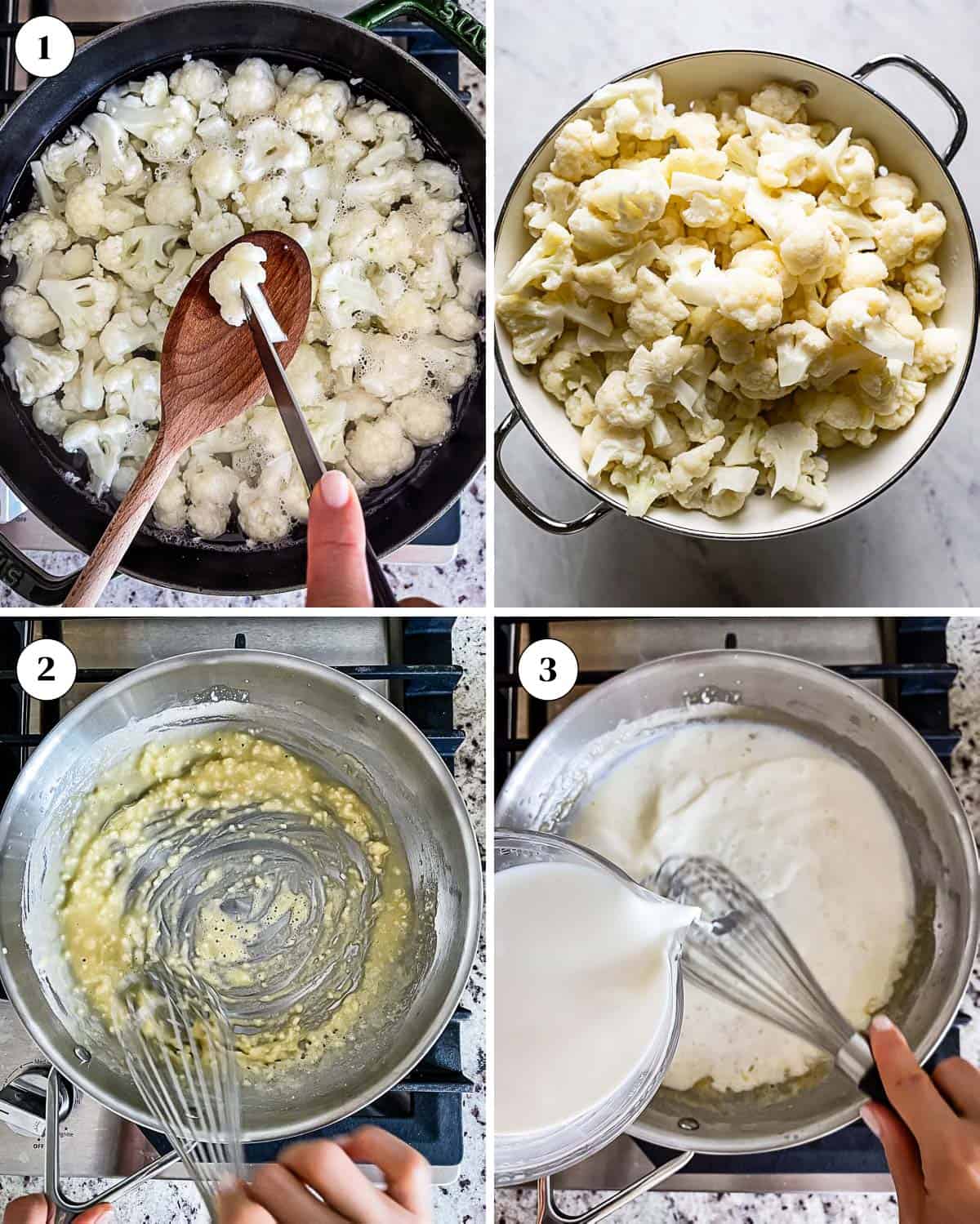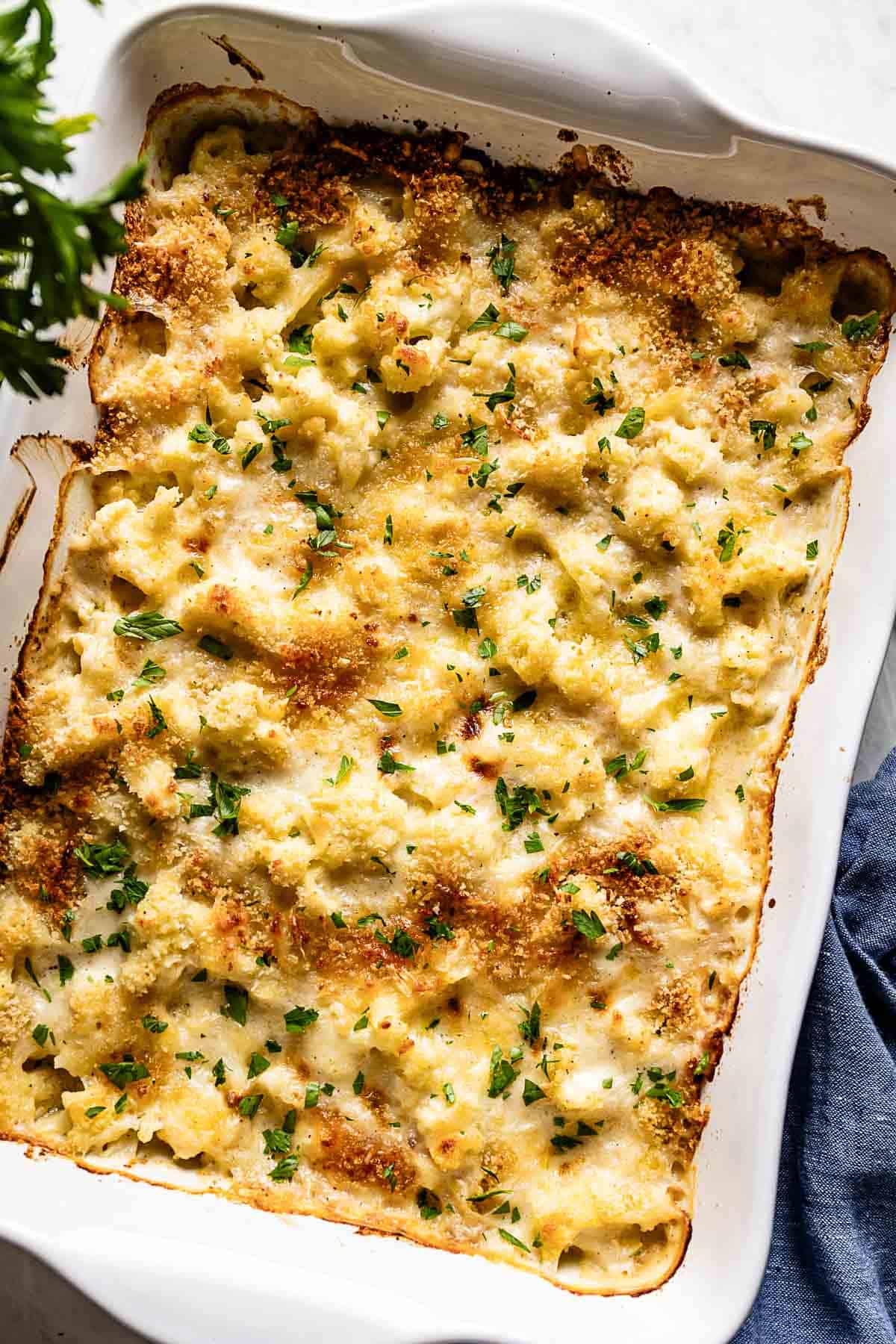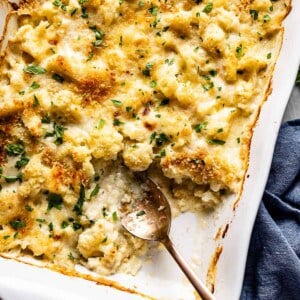If you love cauliflower as much as I do, be sure to check out Broccoli and Cauliflower Salad and Cauliflower Curry.
Ingredients
This cheesy cauliflower au gratin recipe requires a list of simple ingredients, one of the main ingredients being cauliflower. We will need:
Cauliflower: The key to this recipe is to have 3 pounds of cauliflower florets. In other words, we want 3 pounds total after cutting into pieces and removing the stalks and stems. I found the best way to ensure enough cauliflower to fill a 9 x 13-inch baking dish is to purchase a 3-pound and 2-pound head of cauliflower. Fresh cauliflower has a higher water content, so in this case, we want cauliflower that is a bit older. Unsalted butter Fresh cloves of garlic: While we prefer fresh garlic cloves, you can use garlic powder, but if you want to take this cauliflower au gratin casserole to the next level, do yourself a favor and use roasted garlic. All-purpose flour Whole milk: Low-fat milk can be used in place of whole milk, but it will not be as creamy. There is also a higher chance of curdling if a lower fat milk is used. Seasonings: A simple mix of Kosher salt, black pepper, and nutmeg elevates the dish to new heights. For extra kick, a pinch of cayenne pepper can also be added. Cheese: We are following along with the Barefoot Contessa’s cheesy cauliflower gratin recipe and using a mix of Gruyere and Parmesan cheese, but sharp cheddar cheese, Swiss cheese, or Fontina can be used in place of the Gruyere. Steer clear of pre-packaged shredded cheese, which contains anti-caking agents and can affect the consistency of the cheesy sauce. Bread crumbs: Yet unlike Barefoot Contessa’s recipe, we went with Panko breadcrumbs for extra crunch. For extra indulgence, you could try crushed Ritz crackers mixed with a bit of melted butter for a salty, buttery crunch. Optional garnish: Fresh parsley gives it a beautiful finish and color. Fresh chives would be a nice addition, too.
How to Make Cauliflower Gratin?
If you are looking for an easy recipe for cauliflower au gratin, you have come to the right place! There are three main parts to making a cauliflower gratin, but I can assure you your efforts will be worth it. Here’s how to do it in a few basic steps:
How to Make Ahead, Store, Freeze, and Reheat?
This scalloped cauliflower recipe is a wonderful make-ahead and can be stored in both the fridge and freezer. To do so properly, simply:
Make Ahead: Blanch the cauliflower and make the creamy sauce up to 2 days in advance. Store each separately in airtight containers in the refrigerator. Or, make the entire casserole dish 1 day in advance. Remove from the fridge at least 30 minutes before baking. Storing Leftovers: Leftover gratin of cauliflower can be stored in an airtight container in the fridge for up to 3 days. Freezing: Cauliflower gratin can be frozen, but keep in mind the texture may be affected once reheated due to the water content in cauliflower. For best results, cool the gratin completely (to prevent the formation of ice crystals) and store it in a freezer-safe airtight container with a piece of plastic wrap directly on the surface. Label, date, and freeze for up to 3 months. Thawing: Thaw frozen gratin overnight or up to 24 hours in the refrigerator. Reheating: Reheat leftovers, uncovered, in a preheated 350 F oven for 15-20 minutes. If reheating frozen but thawed cauliflower gratin, it could take up to 30 minutes. If reheating from frozen, bake at 350 F for 45 minutes – 1 hour, tented with aluminum foil, then remove the aluminum foil during the last 15 minutes of baking.
Roasted Cauliflower Au Gratin: If you enjoy the smoky roasted flavors, instead of blanching your cauliflower, you can roast them in the oven. To do so, drizzle the florets with a tablespoon of olive oil and season with salt and pepper. Bake for 15-20 minutes or just until softened. Transfer it to your baking dish and drizzle the creamy cheese sauce over the cauliflower. Then bake your roasted cauliflower gratin following the recipe as written. Broccoli Cauliflower Au Gratin: For more of a healthy and veggie-packed version, you can swap out half the cauliflower for an equal amount of broccoli instead. You can blanch them at the same time, so it is just a quick and easy swap. Potato and Cauliflower Gratin: If you want to incorporate potatoes into this dish, it is totally possible and easy to do so. Simply swap out one pound of cauliflower for one pound of peeled and cubed Yukon gold potatoes. I recommend cutting the peeled potatoes into bite-sized chunks and boiling them in water until al dente. Be sure to drain them well before adding them to the cheese sauce with the cauliflower florets.
Poultry / Meat: This cauliflower cheese gratin makes the perfect side dish to serve alongside a hearty protein like Turkey Tenderloin, Turkey Meatloaf, Goat Cheese Stuffed Chicken, or Seared Beef Tenderloin. Bread: Make it extra indulgent alongside Brioche Rolls, Air Fryer Garlic Bread, or Foccacia. Side Salad: If you’d prefer to turn this scalloped cauliflower au gratin dish into a vegetarian meal, its rich flavors and textures would pair beautifully with our Butternut Squash Salad, Shaved Brussel Sprout Salad, or Acorn Squash Salad.
Other Cauliflower Side Dishes You Might Like:
It is no secret that this cauliflower bake makes a delicious side dish to serve along with any of your favorite main dishes. Here are a few other cauliflower recipes that you might also like to try:
Cauliflower florets: As noted above, the total weight of the cauliflower is in reference to the cauliflower florets, not the whole head of cauliflower. I’ve found the stalks weigh about 1 pound each per head, so pick up a 2-pound and 3-pound cauliflower head to get 3 pounds of florets in total. Blanching the cauliflower: Make sure to cook the cauliflower in a large pot of boiling salted water and keep a close eye on the texture. We are not cooking the cauliflower all the way through, just enough to parboil it into tender cauliflower florets as it will continue to cook in the oven. Use a large enough skillet to mix everything together: I used a 12-inch skillet (affiliate link), which was large enough to make the cheese sauce, and tossed all the cauliflower so that each floret was coated with the sauce. Patience is key with the bechamel sauce: When you are making the roux (aka bechamel sauce), patience is the key. Do not rush, and be sure to cook the flour with the butter for at least 1 minute so that you cook out the raw flavor of the flour. For ease, make the roux with a wooden spoon, then switch to a whisk when you begin adding the milk. And whatever you do, do not leave it unattended. Look for nape: A simple way to check if the sauce has the right thickness is to dip a wooden spoon in it. When you remove the spoon, the sauce should cling to its back rather than being runny. This is referred to as “nape” in French. Cold milk vs warmed milk: Slightly warmed or room temperature milk mixes better, but we tested the recipe with cold milk, and it worked just as well. Don’t fret about consistency: Upon first making the cheese sauce, it may seem a little loose, but keep in mind that some of the moisture will evaporate in the oven, and it will thicken as it bakes. Browning: If the cauliflower is tender, but the top hasn’t browned enough, place it under the broiler for 1 minute or until browned to your liking. Make sure to check it often to avoid burning.
Miso Cauliflower Rice Cauliflower Steak Sandwich Recipe Cauliflower Celery Soup Cauliflower and Lentil Salad

